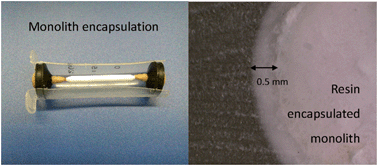Development of a resin based silica monolithic column encapsulation
Abstract
As monolithic columns become more extensively used in separation based applications due to their good flow and high surface characteristics, there has arisen the need to establish simple, reliable fabrication methods for fluidic coupling and sealing. In particular, the problem of liquid tracking between a monolith's outer surface and the sealing wall, resulting in poor flow-through performance, needs to be addressed. This paper describes a novel resin-based encapsulation method that penetrates 0.3 mm into the outer surface of a 4 mm diameter monolith, removing the so-called wall-effect. Results based on the peak analysis from 1 µL of 0.4% thiourea injected into a 98 : 2 water : methanol mobile phase flowing at 1 mL min−1 indicate excellent flow conservation through the monolith. A comparison of peak shape and height equivalent to a theoretical plate (HETP) data between the reported resin-based method and the previously reported heat shrink tubing encapsulation methodology, for the same batch of monoliths, suggests the resin based method offers far superior flow characteristics. In addition to the improved flow properties, the resin casting method enables standard polyether ether ketone (PEEK) fittings to be moulded and subsequently unscrewed from the device offering simple reliable fluidic coupling to be achieved.



 Please wait while we load your content...
Please wait while we load your content...